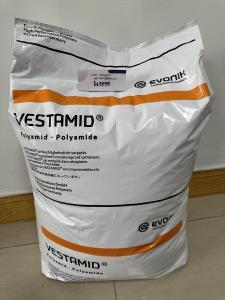PEEK L4000G Geymany赢创德固赛 Evonik
| 品牌 | Geymany赢创固德赛 Evonik |
|---|---|
| 货号 | 面议 |
| 牌号 | PEEK L4000G |
| 型号 | L4000G |
| 品名 | PEEK |
| 外形尺寸 | 25kg/盒 |
| 产品用途 | 阻燃 |
| 生产企业 | 德国赢创德固赛 |
17年专注工程塑料
生产,销售,技术一条龙服务广泛应用于电子,电器,通讯设备,汽车制造,航空航天,玩具,生活日用品等行业
不仅仅只是一次买卖——万物皆以延续而存在
网址:www shermancn com (公司内部物性查询正在建立中... 敬请期待)
Evonik Industries
Evonik Industries AG is a stock-listed German specialty chemicals company headquartered in Essen, North Rhine-Westphalia, Germany. It is the second largest chemicals company in Germany, and one of the largest specialty chemicals companies in the world. It is predominantly owned by the RAG Foundation and was founded on 12 September 2007 as a result of restructuring of the mining and technology group RAG.
Evonik Industries united the business areas of chemicals, energy and real estate of RAG, while mining operations continue to be carried out by RAG. Since then, the energy and real estate business areas have been divested, with no share being held in the former and a minority share still being held in the latter. Its specialty chemicals business generates around 80% of sales in areas in which it holds leading market positions. Evonik Industries employs about 37,000 people and carries out activities in more than 100 countries. The operating activities are organized into six business units which are a part of the chemicals business area. Evonik is the main sponsor of German football club Borussia Dortmund.
History
World War II and involvement in the Holocaust
During World War II, one of Degussa's (Deutsche Gold- und Silber-Scheide-Anstalt, "German Gold and Silver Refining") subsidiaries, Degesch (translation: German Corporation for Pest control), was the main manufacturer and distributor of the chemical Zyklon B, which was used to murder people in gas chambers of German extermination and concentration camps during the Holocaust.Furthermore, gold dental fillings, which had been forcefully removed from the mouths of concentration-camp inmates, had been processed by Degussa.[5] The company's partnership Deutsche Gasrusswerke (DGW) employed Jewish slave laborers at Gleiwitz concentration camp, a subcamp of Auschwitz. Degussa estimated its war losses at 111 million Reichsmarks, almost USD$0.5 billion in 2012 dollars.
In 1998, Degussa requested the American historian Peter Hayes to clarify the company history during the Third Reich
While constructing the Holocaust Memorial in Berlin, it became public that the plasticizer and the anti-graffiti coating of the memorial were produced by Degussa, resulting in a pause of the construction works until the matter is clarified. In November 2003, the memorial's trustees decided to finish the building with the involvement of Degussa.
After World War II
In 2006, RAG acquired Degussa AG,[9] which was later renamed Evonik-Degussa GmbH.
Historically, Evonik Industries' businesses were part of RAG activities. The idea of splitting the company was put forward in 2005. The background of this idea was that RAG's core business of coal mining is carried out under government contract in Germany, while businesses transferred to Evonik compete in international markets. This structure did not permit the payment of dividends to the shareholders, which limited shareholders' readiness to inject equity into the RAG, which thereby restricted the company's ability to access fresh capital. As the first step, RAG's shareholders sold their shares to RAG foundation (RAG-Stiftung) to split RAG.
The Foundation was established on 10 July 2007, and Evonik Industries was created on 12 September 2007.
The original plan foresaw the IPO of Evonik Industries in the first half of 2008. However, this plan was postponed until mid-2010 at the earliest, and the RAG Foundation started to look for strategic investors, while still holding on to the plans for a midterm IPO.In June 2008, the private equity firm CVC Capital Partners bought a stake of 25.01% in the company. Among many other private equity investors who bid for the stake (amongst them Blackstone Group and 3i), Russian Gazprom was reported to have considered buying a stake in Evonik Industries. The IPO, by now planned for fall of 2011, was once again postponed in September 2011, this time citing the "current state of financial and capital markets and their prospects."RAG Foundation had planned for Evonik's IPO to take place in 2012, but this was postponed as a result of poor market conditions. Evonik shares have been traded on the Frankfurt Stock Exchange since 25 April 2013. Prior to the IPO the company had given institutional investors the opportunity to acquire around 14% of the shares for €2 billion.
Since 5 March 2015, the shareholding structure of the Evonik Industries AG is composed as follows:
67,9%: RAG Foundation
14,0%: Gabriel Acquisitions GmbH (a company owned by funds advised by CVC Capital Partners)
18,1%: Free float
Operations
Evonik divested its former holdings in the areas of energy and real estate and now focuses on the core business of specialty chemicals.
The Chemicals Business Area of Evonik emerged from Evonik Degussa GmbH (formerly Degussa GmbH — an acronym of Deutsche Gold- und Silber-Scheide-Anstalt (German Gold and Silver Separating Works)) based in Essen, Germany. It employs about 34,000[21] people and is one of the world's largest producers of specialty chemicals. It includes six business units: Advanced Intermediates, Consumer Specialties, Coatings & Additives, Inorganic Materials, Health & Nutrition and Performance Polymers.[22] Degussa was acquired by RAG in 2006. Its latest acquisition is the Tippecanoe Labs plant site at Lafayette, Indiana from Eli Lilly on 1 January 2010.[23] In November, a plant for the production of DL-methionine was opened in Singapore. At a cost of €500 million, it is the largest investment to date in the chemical sector in the company's history.[24] In June 2014, the Supervisory Board resolved to restructure the Group, with plans for the six chemical segments to be bundled into three GmbH (limited liability) companies from 2015.
Energy Business Area
The former energy business portion of Evonik was operated through Evonik Steag GmbH (formerly STEAG), which is the fifth largest power company in Germany, based in Essen. The company operates fourteen hard coal-fired power plants, of which eleven are located in Germany, and one in Turkey, one in Colombia and one in the Philippines, and two industrial power plants. It also operates in the field of transport, processing and distribution of hard coal, coke and byproducts from coal processing, as well as in the field of gas supply, transport and trading.[26] In December 2010, Evonik Industries signed an agreement to sell 51% of shares in its energy business to a consortium of municipal utilities in Germany's Rhine-Ruhr region. The agreement was finalized on 2 March 2011. The remaining 49% were acquired by the consortium for €570 million in August 2014.
Evonik Immobilien GmbH used to manage around 60,000 company-owned residential units in Germany. In addition, it had a 50% stake in TreuHandStelle GmbH, which manages more than 70,000 residential units. Evonik Immobilien GmbH was amalgamated with TreuHandStelle GmbH and placed on a more independent basis in the medium term.[28] As per the resolution of the general meeting held on 25 November 2011, the name of the subsidiary Evonik Immobilien GmbH was changed to Vivawest GmbH. On 1 January 2012, Vivawest merged with residential management company THS under the name Vivawest. In 2013, Evonik sold the majority of its shares in Vivawest to the RAG Foundation, the Evonik pension fund, and the coal mining corporation RAG AG. Evonik now holds only 10.9%, and there are plans to sell this stake too.
PEEK性质
PEEK(聚醚醚酮)塑胶原料是芳香族结晶型热塑性高分子材料,具有机械强度高、耐高温、耐冲击、阻燃、耐酸碱、耐水解、耐磨、耐疲劳、耐辐照及良好的电性能。
耐高温性:具有较高的玻璃化转变温度(Tg=143℃)和熔点(Tm=343℃),其负载热变形温度高达316℃,瞬时使用温度可达300℃。
机械特性:具有刚性和柔性,特别是对交变应力下的抗疲劳性非常突出,可与合金材料相媲美。
自润滑性:具有优良的滑动特性,适合于严格要求低摩擦系数和耐磨耗用途的场合,特别是用碳纤维、石墨各占一定比例混合改性的PEEK自润滑性能更佳。
耐腐蚀性:除浓硫酸外,PEEK不溶于任何溶剂和强酸、强碱,而且耐水解,具有很高的化学稳定性。
阻燃性:具有自熄性,即使不加任何阻燃剂,可达到UL标准的94V-0级。
易加工性:具有高温流动性好,而热分解温度又很高的特点,可采用多种加工方式:注射成型、挤出成型、模压成型及熔融纺丝等。
耐剥离性:耐剥离性很好,因此可制成包覆很薄的电线或电磁线,并可在苛刻条件下使用。
耐疲劳性:在所有树脂中具有 的耐疲劳性。
耐辐照性:耐高辐照的能力很强,超过了通用树脂中耐辐照性 的聚苯乙烯。可以作成γ辐照剂量达1100Mrad时仍能保持良好的绝缘能力的高性能 。
耐水解性:PEEK及其复合材料不受水和高压水蒸气的化学影响,用这种材料作成的制品在高温高压水中连续使用仍可保持优异特性。
发烟性:在塑料中PEEK具有 发烟性。
毒气逸散性:PEEK与很多有机材料相同,在高温分解时,PEEK主要产生二氧化碳和一氧化碳,使用英国航行器测试标准BSS 7239可以检测到极低浓度的毒气逸散,这种检测过程需要在1立方米的空间内完全燃烧100克样品,然后分析其中所产生的毒气,毒性指数定义为在正常情况下产生的毒气浓度综合与30分钟可以使人致命的剂量之比,PEEK450G的指数为0.22,且没有检测到酸性气体。
绝缘稳定性:具有良好的电绝缘性能,并保持到很高的温度范围。其介电损耗在高频情况下也很小。
稳定性:具有优越的尺寸稳定特性,这对某些应用来说有的
应用
由于聚醚醚酮PEEK具有优良的综合性能,在许多特殊领域可以替代金属、陶瓷等传统材料。该塑料的耐高温、自润滑、耐磨损和抗疲劳等特性,使之成为当今 的高性能工程塑料之一,它主要应用于航空航天、汽车工业、电子电气和医疗器械等领域。
1、航空航天领域:可加工成各种高精度的飞机零部件,由于其耐水解、耐腐蚀和阻燃性能好,可加工成飞机的内/外部件及火箭发动机的许多零部件。
2、汽车制造:聚醚醚酮PEEK一直成功地用于汽车制造业,由于它具有良好耐摩擦性能,可以替代金属(包括不锈钢、钛)制造发动机内罩、汽车轴承、密封件和刹车片等。
3、工业领域:由于具有良好机械性能、耐高温、耐磨耗,并能耐高压,常用来制造压缩机阀片、活塞环、密封件等。
4、医疗器械:可在134℃下经受3000次循环高压灭菌,这一特性能满足灭菌要求高、需反复使用的手术和牙科设备的制造,加上它的抗蠕变和耐水解性,用它可制造需高温蒸汽消毒的各种医疗器械。尤为重要的是PEEK无毒、质轻、耐腐蚀,是与人体骨骼最接近的材料,因此可采用PEEK代替金属制造人体骨骼。
5、绝缘材料:PEEK因具有优良的电气性能,在高温、高湿等恶劣条件下,聚醚醚酮的绝缘性能仍能保持,是理想的电绝缘材料,特别是在半导体工业中得到广泛应用。
6、是一种新型工程塑料,可用作耐高温结构材料和电绝缘材料,可与玻璃纤维或碳纤维复合制备增强材料。
7、改性聚醚醚酮有黑色碳纤增强导电聚醚醚酮、红色碳纤增强导电聚醚醚酮、有矿物增强聚醚醚酮、有玻纤增强聚醚醚酮及PEEK树脂。虽然聚醚醚酮具有许多优良性能,但是价格昂贵,限制了其在一些领域的应用。另外,它的冲击强度较差,为了进一步提高其性能,以满足各个领域的综合性能和多样化需要,可采用填充、共混、交联、接枝等方法对其进行改性,以得到性能更加优异的PEEK塑料合金或PEEK复合材料。例如:PEEK与聚醚共混可得到更好的力学性能和阻燃性;PEEK与PTFE共混制成复合材料,具有突出的耐磨性,可用于制造滑动轴承、动密封环等零部件;PEEK用碳纤维等填充改性,制成增强的PEEK复合材料,可大大提高材料的硬度、刚性及尺寸的稳定性等。
Polyether ether ketone (PEEK) is a colourless organic thermoplastic polymer in the polyaryletherketone (PAEK) family, used in engineering applications. The polymer was first developed in November 1978, later being introduced to the market by Victrex PLC, then Imperial Chemical Industries (ICI) in the early 1980s.
Properties
PEEK is a semicrystalline thermoplastic with excellent mechanical and chemical resistance properties that are retained to high temperatures. The processing conditions used to mould PEEK can influence the crystallinity and hence the mechanical properties. Its Young's modulus is 3.6 GPa and its tensile strength is 90 to 100 MPa.PEEK has a glass transition temperature of around 143 °C (289 °F) and melts around 343 °C (662 °F). Some grades have a useful operating temperature of up to 250 °C (482 °F).The thermal conductivity increases nearly linearly with temperature between room temperature and solidus temperature.It is highly resistant to thermal degradation, as well as to attack by both organic and aqueous environments. It is attacked by halogens and strong Br?nsted and Lewis acids, as well as some halogenated compounds and aliphatic hydrocarbons at high temperatures. It is soluble in concentrated sulfuric acid at room temperature, although dissolution can take a very long time unless the polymer is in a form with a high surface-area-to-volume ratio, such as a fine powder or thin film. It has high resistance to biodegradation.
Applications
PEEK is used to fabricate items for demanding applications, including bearings, piston parts, pumps, high-performance liquid chromatography columns, compressor plate valves, and electrical cable insulation. It is one of the few plastics compatible with ultra-high vacuum applications, which makes it suitable for aerospace, automotive, and chemical industries.PEEK is used in medical implants, e.g., use with a high-resolution magnetic resonance imaging (MRI), for creating a partial replacement skull in neurosurgical applications.
PEEK is used in spinal fusion devices and reinforcing rods. It is radiolucent, but it is hydrophobic causing it to not fully fuse with bone.PEEK seals and manifolds are commonly used in fluid applications. PEEK also performs well in high temperature applications (up to 500 °F/260 °C).[12] Because of this and its low thermal conductivity, it is also used in FFF printing to thermally separate the hot end from the cold end.
Processing options
PEEK melts at a relatively high temperature (343 °C / 649.4 °F) compared to most other thermoplastics. In the range of its melting temperature it can be processed using injection moulding or extrusion methods. It is technically feasible to process granular PEEK into filament form and 137D printing parts from the filament material using fused deposition modeling – FDM (or fused filament fabrication – FFF) technology. PEEK filaments have been demonstrated for producing medical devices up to class IIa. With this new filament, it is possible to use the FFF method for different medical applications like dentures.
In its solid state PEEK is readily machinable, for example, by (CNC) milling machines and is commonly used to produce high-quality plastic parts that are thermostable and both electrically and thermally insulating. Filled grades of PEEK can also be CNC machined, but special care must be taken to properly manage stresses in the material.
PEEK is a high-performance polymer, but its high price, due to its complex production process, restricts its use to only the most demanding applications.
Shape-memory PEEK in biomechanical applications
PEEK is not traditionally a shape-memory polymer; however, recent advances in processing have allowed shape-memory behaviour in PEEK with mechanical activation. This technology has expanded to applications in orthopedic surgery.


